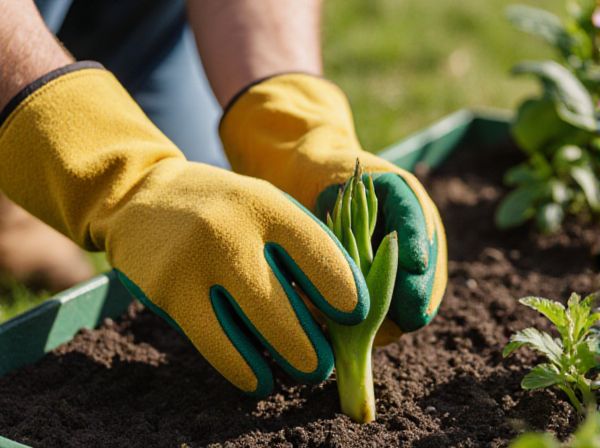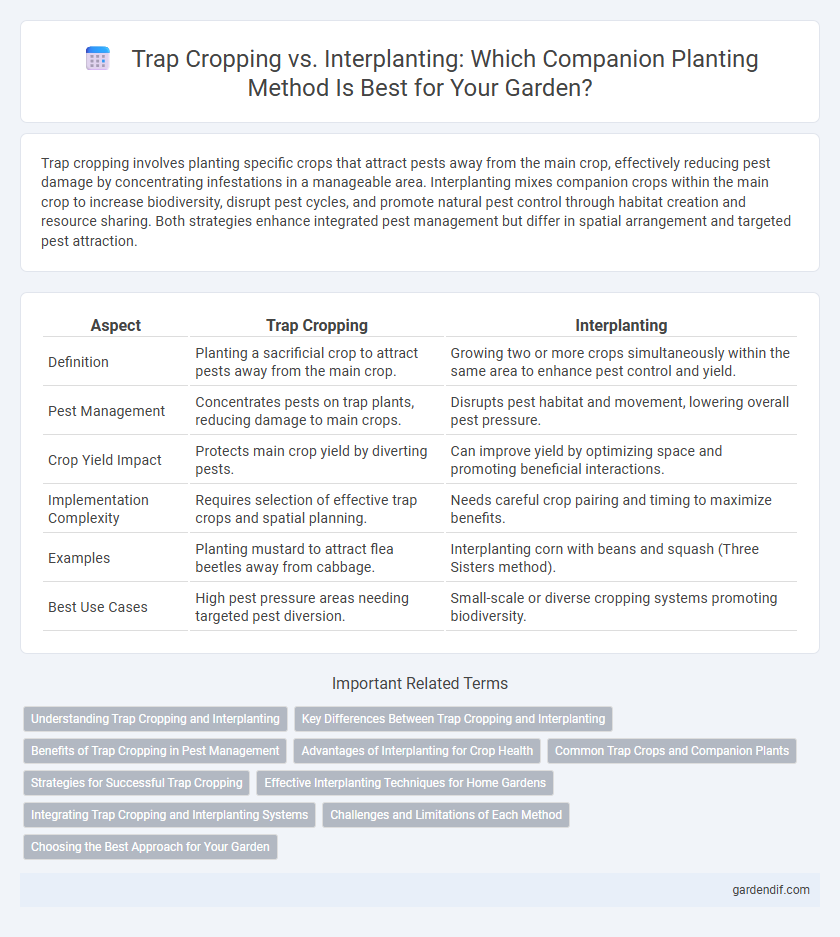
Trap cropping vs interplanting Illustration
Trap cropping involves planting specific crops that attract pests away from the main crop, effectively reducing pest damage by concentrating infestations in a manageable area. Interplanting mixes companion crops within the main crop to increase biodiversity, disrupt pest cycles, and promote natural pest control through habitat creation and resource sharing. Both strategies enhance integrated pest management but differ in spatial arrangement and targeted pest attraction.
Table of Comparison
| Aspect | Trap Cropping | Interplanting |
|---|---|---|
| Definition | Planting a sacrificial crop to attract pests away from the main crop. | Growing two or more crops simultaneously within the same area to enhance pest control and yield. |
| Pest Management | Concentrates pests on trap plants, reducing damage to main crops. | Disrupts pest habitat and movement, lowering overall pest pressure. |
| Crop Yield Impact | Protects main crop yield by diverting pests. | Can improve yield by optimizing space and promoting beneficial interactions. |
| Implementation Complexity | Requires selection of effective trap crops and spatial planning. | Needs careful crop pairing and timing to maximize benefits. |
| Examples | Planting mustard to attract flea beetles away from cabbage. | Interplanting corn with beans and squash (Three Sisters method). |
| Best Use Cases | High pest pressure areas needing targeted pest diversion. | Small-scale or diverse cropping systems promoting biodiversity. |
Understanding Trap Cropping and Interplanting
Trap cropping involves planting specific crops near the main crop to attract pests away, protecting the primary plants by exploiting pest preferences. Interplanting mixes different crop species together, enhancing biodiversity and disrupting pest habitats to reduce infestations naturally. Both techniques improve integrated pest management by leveraging plant-pest relationships for sustainable agriculture.
Key Differences Between Trap Cropping and Interplanting
Trap cropping involves planting a sacrificial crop to attract pests away from the main crop, effectively reducing pest damage, while interplanting integrates different crops in the same area to promote biodiversity and improve pest control through natural predator attraction. Trap crops are typically more pest-specific and require strategic placement to intercept pests, whereas interplanting creates a mixed environment that confuses pests and enhances beneficial insect populations. The key difference lies in the targeted pest management of trap cropping compared to the broader ecological benefits and pest suppression achieved through interplanting.
Benefits of Trap Cropping in Pest Management
Trap cropping effectively reduces pest damage by attracting harmful insects away from primary crops, thereby lowering the need for chemical insecticides. This targeted pest management strategy enhances crop health and yield while promoting ecological balance by supporting beneficial predator populations. Implementing trap crops like mustard or radish in vegetable fields offers sustainable protection, minimizing pest outbreaks and improving overall farm productivity.
Advantages of Interplanting for Crop Health
Interplanting enhances crop health by promoting biodiversity, which naturally reduces pest populations and disease spread through improved ecosystem balance. This method also improves soil fertility and moisture retention by diversifying root structures and nutrient uptake. Interplanting increases resilience against environmental stresses, leading to more stable and sustainable crop production.
Common Trap Crops and Companion Plants
Common trap crops used for pest management include mustard, radish, and marigold, which attract pests away from main crops, enhancing crop protection. Companion plants such as basil, garlic, and chives improve growth and repel pests through natural chemical interactions, promoting healthier yields. Trap cropping and interplanting together create an integrated pest management strategy by combining pest diversion with beneficial plant interactions.
Strategies for Successful Trap Cropping
Effective trap cropping involves selecting highly attractive plant species to lure pests away from main crops, ensuring timely planting to coincide with pest life cycles and providing appropriate maintenance to sustain trap crops' vigor. Strategic placement of trap crops on field borders or within cropping systems enhances pest interception and minimizes infestation on primary crops. Integrating trap cropping with monitoring and targeted pest control measures maximizes crop protection and supports sustainable pest management.
Effective Interplanting Techniques for Home Gardens
Effective interplanting techniques for home gardens involve strategically placing companion plants to maximize pest control and improve crop yields by attracting beneficial insects and deterring harmful pests. For example, planting marigolds alongside tomatoes can suppress nematodes and repel aphids, while basil interplanted with peppers enhances flavor and growth. This method fosters biodiversity, maintains soil health, and optimizes garden space more efficiently than trap cropping.
Integrating Trap Cropping and Interplanting Systems
Integrating trap cropping and interplanting systems enhances pest management by combining targeted pest attraction with diverse plant growth that confuses and repels pests. Trap crops such as mustard or clover lure pests away from main crops while interplanted herbs and flowers increase biodiversity, improving natural predator habitats and pollination. This synergy optimizes crop protection, reduces pesticide need, and boosts overall agricultural sustainability.
Challenges and Limitations of Each Method
Trap cropping faces challenges such as requiring precise timing and spatial arrangement to effectively lure pests away from main crops, which can lead to labor-intensive management and potential failure if the trap crop attracts more pests than anticipated. Interplanting limitations include increased complexity in plant maintenance, competition for nutrients, water, and sunlight among crops, and difficulties in pest monitoring due to the mixed planting pattern. Both methods demand careful planning and may not be universally effective across different pest species or environmental conditions.
Choosing the Best Approach for Your Garden
Trap cropping involves planting specific plants that attract pests away from your main crops, creating a protective buffer and reducing pest damage. Interplanting mixes complementary plants throughout the garden to confuse pests and improve biodiversity, enhancing natural pest control and soil health. Select trap cropping when targeting particular pest species or protecting high-value crops, while interplanting suits diverse gardens aiming for balanced ecosystems and long-term resilience.
Trap cropping vs interplanting Infographic

 gardendif.com
gardendif.com